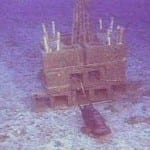The Corps has installed metal grates on the top of fish ladders for two principal reasons: To stop poaching and to prevent fish from jumping out of the fish ladder as they proceed upwards, said Doug Grothe, Englebright Lake Park Manager for the Corps.
“I think that a fish has missed the mark and jumped outside the ladder only once that we know of,” Grothe said. “But once is too many when you’re dealing with an endangered species.”
The species in question, including the spring-run Chinook Salmon and the Central Valley steelhead trout, typically spawn in the autumn, Grothe said. Both species are anadromous, meaning they return to freshwater to spawn after spending their adult lives in the ocean.
Both species are listed under the Endangered Species Act of 1973.
Whereas female salmon die soon after spawning, steelhead are iteroparous, meaning they are able to spawn several times, each time separated by months.
The populations of both fish species have been adversely affected by the installation of dams on the rivers that filter down from the Sierra, Grothe said.
Thus, the Corps is attempting to improve their population girth by installing various fish ladders where possible.
The Daguerre Point Dam is only 26 feet high and was built in 1906 to capture sediment siphoning through the Yuba as a result of hydraulic mining operations. The installation of a fish ladder was an easy solution, Grothe said.
Englebright Dam is 260 feet high, which precludes fish ladders, although officials are attempting to formulate exotic solutions to the impasse such as catching the fish and physically delivering them to the reaches of the river above the dam and then collecting their spawn and physically delivering them back to the lower reaches.
“That’s pretty expensive and labor intensive,” Grothe said.
For now, the Corps is content to concentrate on areas just below the Englebright Dam.
In an effort to further bolster fish habitat, the Corps injected more than 5,000 tons of gravel into the river to provide better spawning habitat for the fish, which like to lay eggs in loose sediment at the bottom of the river. That section of river consisted of bedrock before the injection, Grothe said.
“We are just now studying the effects of that project, but it looks promising,” he said.
The South Yuba River Conservation League issued a statement on their website which simultaneously praised the Corps for addressing the issues, while chastising the group for what it perceived as “decades of neglect.”
“As a result of SYRCL’s lawsuit, the Corps put grates on top of the fish ladders to finally stop poaching and lethal jumps out of the ladders,” the statement reads.
“These actions are small steps of improvement compared to the ultimate solution — removing this archaic dam,” the statement continued. “Nonetheless, these actions reflect a new era where wild salmon of the Yuba are finally getting the attention they deserve.”Matthew Renda





































